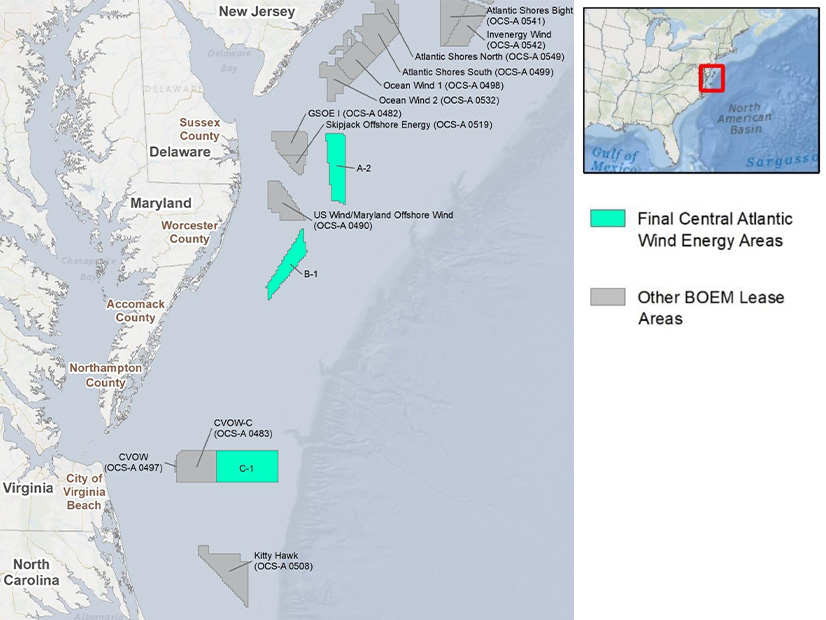
The Bureau of Ocean Energy Management has determined its planned lease of Central Atlantic wind energy areas would have no significant impact on the ocean, the creatures that live there or the people who use it for other purposes.
The final environmental assessment, announced June 6 sets the stage for the BOEM to auction lease areas along the Delaware, Maryland and Virginia coasts this year. The target date is Aug. 14.
The analysis does not examine the impacts of construction and operation of wind turbines and the associated infrastructure. It analyzes only the research that would determine the area’s suitability for future wind farms and underwater transmission.
This research includes site assessment and site characterization efforts such as placement of meteorological buoys and oceanographic devices, as well as geophysical, geotechnical, archaeological and biological surveys.
The three wind energy areas — designated A-2, B-1 and C-1 — total 356,545 acres and stand as little as 19 nautical miles from shore. BOEM expects the four lease areas would average 80,000 acres each.
B-1 will not be offered in this year’s auction because of the potential conflicts there between offshore wind turbines and nearby military and space flight activities. BOEM concluded the scope of constraints and cost of mitigation measures needed for construction were too great.
However, B-1 was included in the environmental assessment because it may be included in a later lease sale after NASA and the Department of Defense complete an in-depth review of what activities could co-exist there, and under what conditions.
Site assessment and site characterization were projected to have a negligible or negligible-to-minor impact on each of the resources evaluated, which ranged from air quality to fishing to military operations to sea turtles.
BOEM’s Central Atlantic region stretches from Delaware Bay to Cape Hatteras.
The world’s largest naval base, multiple fighter wings, a bombing and gunnery range and a space launch facility all are sited close to water’s edge, and the Department of Defense has raised concerns about incompatibility with wind turbines. (See Potential Military/NASA Conflict with OSW Seen in Wind Energy Area.)
Some interagency friction was reported as BOEM attempted to prepare the region for offshore wind development, but by the time Central Atlantic wind energy auction plans were announced in late 2023, the Department of Defense and NASA offered supportive statements. (See BOEM to Auction Wind Energy Areas in Central Atlantic.)
The concerns about building wind turbines in area B-1 apparently do not extend to doing research work there, or in A-2 or C-1.
The environmental assessment predicts 201 to 377 round trips from port by an array of research vessels, and states that is not a large number when spread across the anticipated five- to seven-year research window or when compared with the heavy marine traffic already seen in the area.
Potential conflicts with the military would be averted through effective coordination with military commanders and the U.S. Coast Guard, the report concludes, although site-specific stipulations may be needed.
In a June 6 news release, BOEM Director Elizabeth Klein said development would move forward collaboratively: “We will continue to work closely with Tribes, our other government partners, ocean users, and the public to ensure that any development in the region is done in a way that avoids, reduces or mitigates potential impacts to ocean users and the marine environment.”
BOEM also plans offshore wind energy auctions in 2024 in the Gulf of Maine, the Gulf of Mexico and Oregon.



